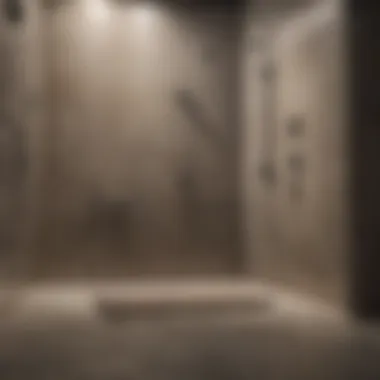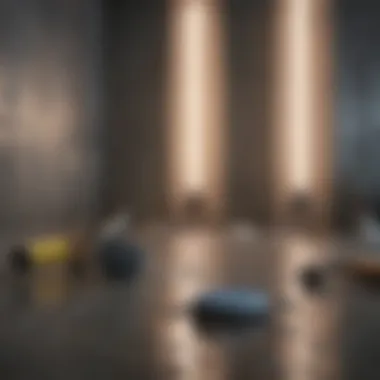Affordable Shower Remodeling: Smart Strategies Revealed


Intro
Remodeling your shower can seem daunting, especially when it comes to costs. However, with careful planning and research, it is possible to achieve your goals without exceeding your budget. In this article, we will explore methods and materials that are both affordable and high-quality. The focus will be on strategic choices and DIY projects that can simplify the process.
Analysing your needs is the first step. Understanding the desired outcome and identifying what's essential versus what's luxury can help make critical decisions. Material choice will be an important part of the planning as well.
Here is what to consider:
- Types of materials for shower enclosure and flooring
- The pros and cons of undertaking parts of the work yourself
- Alternatively, when might it be better to hire profeessional assistance
Before diving into detailed methods, let's explore financial aspects that may free up some cash for this project.
Understanding Loans
In specific situations, utilizing loans may be beneficial for your remodeling project. Loans can provide the necessary capital needed while maintain budget for other expenses.
Types of Loans
Personal loans are among the most common options. They typically offer a fixed amount at a fixed interest rate. Some may also consider home equity loans. This type of loan uses the house itself as collateral. It may have a lower interest than a personal loan depending on your lender.
Loan Eligibility Criteria
The eligibility for loans generally involves an assessment of credit score and income level. It's vital to establish a reliable assessment to gauge which type fits your needs the best.
Pros and Cons of Taking Out a Loan
Taking out a loan has some benefits, such as:
- Immediate access to funds
- Potential for tax deducibility on interest payments
- Flexible payment options
However, there are downfalls to consider too:
- Risk of debt accumulation if payments are missed
- Interest rates can vary greatly
- Additional fees from lenders can be titling effect on overall cost
Overall, obtaining loans should be evaluated carefully.
By understanding loans better, homeowners can begin to explore renovation with lesser obstacles. With financial strategies in place, the focus can shift back to the remodeling task, guiding us now toward deciding materials and looking at DIY efforts next.
Understanding Shower Remodeling
Remodeling your shower can be a beneficial endeavor for both the aesthetics and functionality of your bathroom. Many homeowners find that after years of use, their showers no longer meet their needs or reflect their style. Understanding shower remodeling involves several key elements, including design choices, material selections, and installation methods.
By exploring ‘Understanding Shower Remodeling,’ readers gain insights into how to approach their renovation projects wisely. This can ultimately lead to improved comfort, increased home value, and a more satisfying overall experience in the bathroom. If done correctly, remodeling can also significantly enhance water efficiency and, in turn, contribute to monthly utility cost savings.
Why Remodel Your Shower?
Several reasons compel homeowners to consider remodeling their showers. Perhaps it is motivated by stylistic evolution, the desire for increased luxury, or necessity stemming from damage.
- Updated Appearance: A fresh look can create a more inviting environment. Outdated designs can detract from overall home aesthetics.
- Enhanced Functionality: The layout or features in an old shower may no longer sufficently meet your needs. Sometimes just a better shower head or additional storage can greatly improve the space's utility.
- Increased Home Value: Some renovations add real estate value. A well-executed shower remodel can attract potential buyers and provide return on investment (ROI).
- Water Efficiency: Modern fixtures almost alwasy meet higher efficiency not only benefit the ecosytem but can also lower your water bill.
Each of these point accentuates why this remodeling task infact is worth every penny spent. A committed approach leads to long-lasting satisfaction.
Determining Your Budget
A core part of understanding shower remodeling is establishing a clear budget. Cost is a crucial factor that influences all decisions thereafter.
- Estimate Costs for Materials: Generating an accurate estimate involves recollecting necessity versus desire. High-end materials might look appealing, often leading to unfortunate consequences like overspending.
- Account for Labor: Will you do it yourself, or hire an expert? The cost benefits of engaging professionals might outweigh the upfront costs due to quality assurance.
- Include Contingency: Set aside about 10-20% of your total budget to account for unforeseen expenses. Issues with plumbing or water damage can quickly turn a simple project into a major expense.
Overall, by properly assessing costs and budget constraints, you enable a smoother remodeling process. That’s crucial for finishing your work with skill, creativity, and the end result you envisioned.


Assessing Your Current Shower
Assessing your current shower is one of the vital steps in the remodeling process. Before any changes can be made, it is essential to identify not just the visible flaws but also the more subtle, underlying issues. A thorough assessment will guide your decisions in choosing materials and determining a budget.
Identifying Problem Areas
Every remodeling venture begins with the recognition of problems that need addressing. Focus on the areas where you experience inconvenience or dissatisfaction. Common issues include:
- Leaks: This can lead to water damage or mold hazards.
- Inefficient water pressure: This affects the overall shower experience.
- Outdated fixtures: Older taps or showerheads may not perform well and can require replacement.
- Aesthetic degradation: This includes chipped tiles, rust stains, or dysfunctional door closures.
While some problems are easy to see, others may require more inspection. For instance, stains on walls may indicate hidden leaks or deteriorating plumbing. Therefore, determine whether you can manage these flaws with simple fixes or if they require more extensive interventions. Identifying these areas accurately will help as you either plan your DIY approach or consider hiring professionals.
Analyzing Space and Layout
An effective assessment must also consider the layout of your existing shower space. Evaluate the following aspects:
- Dimensions: Measure the height and width accurately to avoid sizing conflicts with new materials.
- Accessibility: Is the current layout convenient? Assess the entry point and surrounding elements.
- Ventilation: Poor airflow can lead to mold. Check if ventilation is inadequate.
- Existing Structure: If you plan to alter the layout, understanding plumbing and electrical arrangements can prevent costly miscalculations.
Evaluating these factors not only reveals what needs to change but also aids in planning how to fit new items effectively. Be mindful of your design ambitions and how they align with the structural limits of the existing shower. A full assessment lays the groundwork for informed decisions that still cater to your financial constraints.
Selecting Affordable Materials
Selecting affordable materials is crucial when remodeling a shower. The materials you choose dictate not only the initial cost but also the overall longevity and aesthetic appeal of your renovation. The right materials can help you save money while still creating a functional and attractive space. Achieving a balance between cost, durability, and appearance is essential.
When considering materials, there are several factors to take into account: durability, maintenance costs, and aesthetic value. High-quality materials may seem more expensive upfront but can provide better longevity and lower maintenance expenses over time. On the other hand, it is equally important to look at options that fit within your budget limits. Understanding where to compromise is vital for a successful remodel.
Tile Options: Budget Choices
Budget-friendly tile choices offer a pathway to stylish design without breaking the bank. Many homeowners enjoy ceramic and vinyl tilesx since they deliver durability and waterproofing. Ceramic tiles can be found in many designs and colors, giving flexibility in style. Vinyl, often represented in sheets or planks, is especially useful where easy installation is a priority. Their cost-effectiveness can match aesthetic aspirations as well as provide good wear as it withstands moisture and traffic.
Consideration of less popular materials can also prove beneficial. Mosaic tiles, for instance, can create a modern look while remaining less expensive than larger tiles. By mixing different styles, it is feasible to maintain a unique feel while sticking to expenses. The potential and versatility in available patterns can especially enrich older-style spaces.
Cost-Effective Fixtures and Faucets
When focusing on faucets and fixtures, economic choices can significantly impact the look of your remodeled shower. Opting for brands like Delta and Moen can yield reliability with affordability. These brands often offer promoion items or seasonal discounts, helping you to achieve even lower prices. A frequent girding misunderstanding is that cheaper means low quality; many-budget fixtures can perform well and maintain their appearance, but verify reliability and product feedback. Cheaper doesn't always mean lesser quality; several average-priced products have favorable durability reviews.
A critical element is to consider water-saving models. Many modern fixtures come with enhanced technology that not only saves on bills but aids in sustainability. It is possible to find items that conserve water without sacrificing pressure—an important facet for good shower performance. Featuring green-rated options can add additional value to your overall shower remodeling project while reflecting attention to market trends.
Shower Doors: Affordable Alternatives
The choice of shower doors is vital in completing the overall look of your renovation. While custom glass doors can be extravagant, there are budget alternatives. Framed showers are generally cheaper than frameless options. You can find polycarbonate or fiberglass doors, which mimic glass without the expensive capability. Making the right choice here depends primarily on how much light immersion you prioritize and design tastes.
Another consideration is buying pre-fabricated models from suppliers like The Home Depot or Lowe's. These options often come at generous discount prices, without complicated modifications needed to fit your space. Condition from your remodel remains important. Assessing overall impacts of these doors enhances utility while optimizing visual detailing. Affordability, alongside strategic aesthetic choice, leads to admirable results without requiring a lavish financial layout.
DIY vs.
Professional Remodeling
When remodeling your shower, one of the first questions you may face is whether to tackle the project yourself or to hire a professional. Each option has its unique set of benefits and challenges. For many homeowners, the desire to stay within budget makes the DIY route a tempting choice. However, complicated installations or specialized techniques may benefit from the expertise of a seasoned contractor. Understanding these factors can inform your decision-making process, ensuring that you achieve the best outcome while avoiding potential pitfalls.
Pros and Cons of DIY
Pros:
- Cost Savings: One of the foremost reasons for choosing to do it yourself is to save money on labor costs. This enables you to allocate your budget towards quality materials or fixtures instead.
- Control Over Changes: When you manage the project, you have more flexibility to make instant changes. This can lead to inherent creativity in design.
- Personal Satisfaction: Completing your own remodel can provide a lasting sense of pride. You can feel a personal connection to the space you've updated.
Cons:
- Time Investment: Undertaking your remodel can demand considerable time, which may disrupt other obligations or be more than you bargained for.
- Lack of Expertise: While many tasks seem straightforward, there can be complicated aspects requiring specialized knowledge.
- Potential for Errors: Mistakes can lead to additional costs, sid she their purpose of saving money. An incorrect installation might cause leaks or other issues.
When to Hire a Professional


Deciding to hire a professional often comes down to a few key factors. If your plumbing or electrical systems are part of the project, it is usually advisable to seek expert help. They possess relevant experience and knowledge, which can prevent significant issues. Another consideration is the overall scope of the project. Larger remodels can quickly become overwhelming for inexperienced individuals. In such cases, contractors can provide ideas, come up with effective solutions, and perhaps result in a more polished final appearance.
A common mistake made by DIY enthusiasts is underestimating the amount of specialized tools and skills required. Purchasing or renting this equipment can be more costly than anticipated.
In summary, thoroughly assess your capabilities while considering time and complexity. Hiring a professional might enhance renovation quality despite higher initial expenditure, leading to greater long-term satisfaction.
Ultimately, each decision is personal. It's beneficial to have a clear and detailed plan whether you select DIY methods or outside help. Keep your long-term goals and preferences at the forefront of your decision, creating a space that you enjoy for years to come.
Step-by-Step Remodeling Process
The step-by-step remodeling process is critical to ensure that a shower renovation is performed efficiently while staying within budget constraints. A well-structured approach not only streamlines the project management but also minimizes the likelihood of unforeseen costs. Following a methodical plan guarantees that vital components are addressed systematically, allowing homeowners to maintain control throughout the painful renovations.
Planning and Design Phase
The planning and design phase is the first crucial step in any remodeling project. It involves assessing wants and needs, developing a layout, and considering the costs associated with different choices. During this phase, take the time to gather ideas and inspirations by researching designs online or in home improvement magazines.
- Identify Your Needs: Decide what you want from your new shower. Is it purely aesthetic improvements, increased water efficiency or enhanced functionality?
- Develop a Budget: Assign clear figures to materials, labor, and unexpected contingencies. Creating a spreadsheet may help to visualize expenses.
- Draw Drafts: Sketching out a layout can clarify how you want the elements to fit together. Use apps or even paper to create a blueprint for your design.
Demolition and Preparation
Demolition is often the most agreeably satisfying part of the process, but it requires careful preparation to avoid potential hazards. Wear personal protective equipment to ensure safety during this phase. Possible steps include:
- Turn Off Water Supply: Always shut off the water to eliminate any surprises while working.
- Remove Existing Elements: Tear out cabinets, tile, shower doors, or other installations to expose the space that needs addressing. Take care with heavy items, as injuries can lead to delay and higher expenses.
Prepare the space for the new installs by cleaning the surfaces and repairing any exposed plumbing or old surfaces needing attention. This preparation increases the longevity of your new choices.
Installation of New Elements
The installation of new elements marks the transition from demolition to reconstruction. This work can elevate the quality of the finished product. Consider key elements:
- Shower Base and Flooring: Ensure the base is properly sealed and leveled to reduce water damage issues in the future.
- Walls and Tiles: Apply tiles uniformly and without errors, as uneven finishes stand out unpleasantly. Pay attention to grout lines and patterns.
- Shower Fixtures: Ensure fixtures match design picks. Check compatibility of water fittings, ensuring proper installation to avoid future leaks.
If entirely undertaking the installation seems overwhelming, you could hire temporary help for complicated aspects, especially plumbing and electric connections.
Finishing Touches
Finishing touches make all the difference in maximizing aesthetic beauty. Although these steps seem minor, they bring everything together and enhance long-term satisfaction. Tidy along these lines:
- Seal and Caulk: Quality caulking prevents leaks and establishes a clean look. Focus on shower joints, making sure everything molds well.
- Add Hardware: Hooks, shelves, and grab bars that improve functionality can now be freshly attached, completing both visual appeal and user usability.
- Final Inspection: Do a thorough walk-through to examine all work carried out. Testing each aspect ensures everything is functioning as expected and involves reviewing closers on shower doors or the correct operation of new fixtures.
Each small detail contributes to the overall renovation outcome, ensuring a splendid space to enjoy for years to come.
A logical planning enables smooth steps toward remodeling and swings nicely with nearly saved finances.
Cost-Saving Tips for Shower Remodeling
Remodeling a shower can be an intensive project. However, implementing cost-saving tips can significantly ease the financial burden. This section focusses on effective ways to save money while ensuring that the remodel does not compromise on quality.
Reuse and Repurpose Existing Materials
During a remodel, it is common for people to overlook the potential of existing materials. Reusing items from the current setup not only cuts costs but also reduces waste. For example, if the tiles are in good condition, consider regrouting instead of replacing them. Sometimes, a simple cleaning can bring back tiles' original shine.
Additionally, think about repurposing items. A vintage mirror or an old cabinet can be integrated into the new design, contributing both character and savings. Salvaging fixtures or decorative items allows homeowners to maintain unique aesthetics. It ties the new elements into the existing design, creating a cohesive look that's both stylish and budget-friendly.
Before starting with new purchases, evaluate what materials you already own. You might be surprised at what can be saved.
Timing Your Remodel to Save Money
The timing of a remodel can greatly affect costs. Specific seasons and months can offer better deals on fixtures and materials. Often, major retailers have periodic sales, usually at the end of a season, when they want to clear out inventory. Planning the project during these times can lead to significant savings. If DIY work is on your list, try to align it with times when suppliers offer discounts on tools as well.
In addition to timing purchases, it is wise to consult professionals off-season. Typically, contractors will have more availability and may even offer discounts to gain work. Getting quotes during slower times can provide leverage in negotiations.


Taking Advantage of Sales and Discounts
Being proactive about seeking sales can be another significant strategy in reducing costs. Here are some ways to find discounts:
- Follow Retailer Promotions: Subscribe to newsletters from home improvement stores like Home Depot or Lowe's to stay aware of upcoming sales.
- Utilize Online Marketplaces: Websites like Craigslist, Facebook Marketplace, or OfferUp often have gently used or surplus items for sale at reduced prices.
- Membership Discounts: Some stores offer savings for members. Investigating these opportunities can pay dividends, especially for larger purchases.
Remember, being patient and vigilant can lead to unexpected savings.
Using a combination of these tips can offer a smarter and more economical path to a desired remodeling outcome. Understanding how to merge budget-conscious decisions with aesthetic goals can help ensure that the remodeled shower proves functional and pleasing without breaking the bank.
Evaluating Long-Term Satisfaction
Assessing long-term satisfaction is crucial when planning a shower remodel. Many homeowners focus merely on the initial cost or aesthetic changes. However, neglecting functionality and durability can lead to regrets and additional expenses down the road.
A well-thought-out remodel should meet not just immediate needs, but also future requirements. For instance, consider how your family's needs might change over time. Are there children who will eventually grow into teenagers? Do you plan on aging in place? Asking these questions introduces a thoughtful approach, ensuring long-term value.
Moreover, evaluating long-term satisfaction helps identify cost-effective decisions instead of purely budget-based choices. It is wise to invest in durable fixtures even they seem pricier up front. This can lower maintenance costs later and contribute to enhancing the overall experience of your freshly remodeled shower.
Following the guidance regarding functionality not only retains the value of your investment but also contributes to comfort and overall satisfaction.
Assessing Functionality and Durability
Functionality should be a central focus during any shower remodel. Assessing how well the fixtures and space work together is key. Ask yourself: Does it provide enough space when using it? Are the controls easy to reach and utilize? Features such as anti-slip surfaces or appropriate water pressure matter for both safety and comfort.
Tips to Enhance Functionality:
- Choose fixtures with multiple settings to cater to different preferences.
- Ensure water efficiency to prevent excessively high utility bills.
- Use durable materials, like ceramic tiles or tempered glass, known for longevity.
- Consider creating extra storage space for toiletries, thus enhancing ease of use.
Durability often directly corresponds with quality. Invest in reliable brands with a solid reputation for long-lasting products. Maintain awareness that lower-priced options may cost more in repairs and replacements down the line. A poorly chosen fixture might serve its purpose for a brief period, but its failure can disrupt daily routines and lead to frustration.
Maintaining Your Newly Remodeled Shower
Long-term satisfaction does not end after installation; maintaining the shower properly is also essential. Maintenance helps to protect your investment, extends the lifespan of materials, and ensures continuous functionality. Additionally, proper care aids in sustaining the shower's initial appearance.
Maintenance Strategies:
- Clean your shower regularly with products designed for specific material types to avoid damage.
- Regularly check seals and grout lines for signs of deterioration or mold; repairs can stave off bigger issues down the line.
- Inspect the fixtures to guarantee there are no leaks which can skyrocket water utility bills.
Additionally, knowing how to predict when certain components may require replacements can help allocate future budgets more effectively. Together, focusing on long-term functionality, durability, and maintenance contributes significantly to overall satisfaction. Eventually, investing wiseley in these areas will lead to not only a pleasant experience but also a truly valuable asset in your home.
Final Thoughts on Budget-Friendly Shower Remodeling
Remodeling your shower does not have to drain your wallet. As outlined throughout this article, there are numerous cost-effective methods and practices that can be employed for a smart remodel. The final thoughts on this subject emphasize not just trimming costs but maximizing overall value and function as well.
Understanding Value vs.
Cost
When considering remodeling your shower, understanding the difference between value and cost is seminal. Cost refers strictly to the expenditures involved in the remodel. Value, however, embodies the benefits received from that investment, both now and over time.
For example, investing in durable fixtures might result in higher upfront costs. However, these items could eliminate the need for frequent replacements, rendering greater long-term savings. Homeowners should focus on materials and updates that not only fit within their budgets but add genuine value to their homes. A simple matrix can be constructed that helps weigh potential expenses against anticipated benefits. Here’s a helpful guideline:
- Identify high-impact areas: Things like water efficiency and ease of maintenance greatly influence future costs.
- Look for lasting quality: Rather than buying the cheapest option, consider product longevity.
- Monitor market value: Research how similar renovations could affect your home’s overall –ber value.
Considering these aspects can prevent financial regret and ensure enduring satisfaction.
Encouraging Sustainable Choices
Budget-friendly remodeling can also align with sustainability efforts. Opting for environmentally friendly materials is not just a trend; it's a necessity for a healthier planet. Here are a handful of practical sustainable choices to consider:
- Recycled Materials: Using recycled glass for shower panels or tiles significantly lowers your carbon footprint.
- Low-Flow Fixtures: Installing low-flow showerheads assists with reducing water usage and consequently lowers utility bills.
- Sustainable Materials: Bamboo or reclaimed wood can replace more traditional materials for vanities or shelving, granting durability while aiding in environmental conservation.
Engaging in sustainable practices during remodeling ensures adhering to budget constraints without compromising the future. As consumers become more conscious of eco-impacts, homes that reflect this commitment could prove more attractive to prospective buyers in the long run.
End
Examining budget-friendly ways to retrofit showers transcends mere financial prudence; it is about assessing value and establishing responsible habits. Choosing the right materials and staying considerate about sustainability fosters long-term satisfaction and tangible benefits – making every dollar invested truly count.







